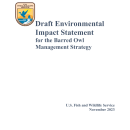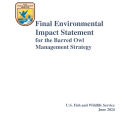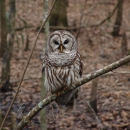States
California, Oregon, WashingtonLATEST NEWS: The Service announced their Record of Decision and final Barred Owl Management Strategy to address the threat of the non-native and invasive barred owl to native northern and California spotted owls. Implementing the Barred Owl Management Strategy is voluntary and will be largely based on available resources and will be done in specific, collaboratively selected areas where it will provide maximum cost efficiency and flexibility for land managers.
The U.S. Fish and Wildlife Service identified competition from non-native and invasive barred owls as one of two main threats to the northern spotted owl’s continued survival (habitat loss is the other).
Barred owls are larger, more aggressive, and more adaptable than northern spotted owls. They displace spotted owls, disrupt their nesting, and compete with them for food. Researchers also have seen a few instances of barred owls interbreeding with or killing spotted owls. Because the spotted owl is already struggling due to its reduced habitat, the effect of the barred owl’s presence is an added stressor. An already vulnerable population has a much more difficult time withstanding dramatic changes in the ecosystem such as the encroachment of a competitor.
Barred owls are native to eastern North America. It is believed they began expanding west of the Mississippi River around the turn of the 20th century. This could have been a natural range expansion or human-caused, or a combination of both. One common theory is that the barred owl’s westward movement was precipitated by changes to the environment in the boreal forest and Great Plains as Europeans increasingly settled there and dramatically altered the landscape. This may have removed natural barriers that previously inhibited the barred owl’s westward expansion. Barred owls now outnumber spotted owls in many portions of the latter’s range.
Researchers have shown strong evidence that spotted owl population declines are more pronounced in areas where barred owls have moved into the spotted owl’s range and are greatest where barred owls have been present the longest. A recent meta-analysis of northern spotted owl population trends found that northern spotted owl populations experienced significant declines on all 11 study areas, ranging from 2 to 9% annually. Barred owl presence on spotted owl territories was the primary factor negatively affecting apparent survival, recruitment, and ultimately, population trend. While habitat components reduced the effect of barred owls on these rates of decline, they did not reverse the negative trend. A link to the meta-analysis publication can be found here.
The Northern Spotted Owl Recovery Plan identified 12 Recovery Actions specific to the barred owl threat, including Recovery Action 29 - “Design and implement large-scale control experiments to assess the effects of barred owl removal on spotted owl site occupancy, reproduction, and survival”. We conducted an experiment to test the effects of removing barred owls from certain areas of spotted owl habitat to see if it would benefit spotted owls. The Barred Owl Removal Experiment demonstrated success in reducing populations of barred owls and a strong, positive effect on survival of northern spotted owls, which arrested the long-term population declines of northern spotted owls within the removal areas. Click here for more information on the experiment.
The Barred Owl Removal Experiment provided information for the implementation of Recovery Action 30 - “Manage to reduce the negative effects of barred owls on spotted owls”. We are implementing this though the development of a barred owl management strategy. The strategy will cover the ranges of the northern and California spotted owl subspecies using a landscape perspective. The approach and recommended actions will vary across the landscape as appropriate to the conditions and urgency in each region.
The purpose of the strategy is to reduce barred owl populations to improve the survival and recovery of northern spotted owls and to prevent declines in California spotted owls from barred owl competition.
For northern spotted owls, the purpose is to stop or slow spotted owl population declines within selected treatment areas in the short term and increase spotted owl populations in the intermediate term. Due to the rapid and ongoing population decline of northern spotted owls, it is critical that we manage invasive barred owl populations to reduce their negative effect on spotted owls before northern spotted owls are extirpated from large portions of their native range. Therefore, action alternatives need to provide for rapid implementation and result in swift reduction in barred owl competition.
Relative to the California spotted owl, the purpose is to limit the invasion of barred owls into the range of the subspecies and respond quickly to reduce barred owl populations that may become established. The southward invasion of the barred owl has reached their range, and future impacts to their populations are inevitable without management.
Record of Decision and Final Barred Owl Management Strategy
The Service announced a decision to adopt a final Barred Owl Management Strategy to protect imperiled northern and California spotted owls in Washington, Oregon and California from invasive barred owls. The notice of availability for the final strategy and Record of Decision will publish in the coming days in the Federal Register at https://www.regulations.gov at Docket No. FWS-R1-ES-2022-0074.
Final Barred Owl Management Strategy
ROD Frequently Asked Questions
Under our Migratory Bird Treaty Act permit, the Service may designate interested Tribes, federal and state agencies, companies, or specific landowners to implement barred owl management on their lands if the actions are consistent with the strategy, the conditions of the permit, and state laws and policies.
Those implementing the plan will be accountable to the Service for annual monitoring and reporting, and we will continually monitor and evaluate implementation efforts along the way.
Absolutely NO public hunting is allowed under the strategy.
Final EIS and Proposed Barred Owl Management Strategy
The Service announced the availability of a final EIS and proposed Barred Owl Management Strategy that addresses the threat of the non-native and invasive barred owls to native northern and California spotted owls. The notice of availability published in the Federal Register on July 5, 2024.
Final EIS
Proposed Barred Owl Management Strategy
FEIS Frequently asked questions
Draft EIS and Draft Strategy (Comment Period - CLOSED)
The Service previously sought public input on a draft EIS and draft Barred Owl Management Strategy.
Draft EIS News release and FAQs
Draft EIS
Draft Barred Owl Management Strategy
Draft EIS Federal Register Notice
Public Meetings for the DEIS (Comment Period CLOSED)
• Dec 4, 2023 from 6-8 p.m. Pacific Time.
• Dec 14, 2023 from 6-8 p.m. Pacific Time.
Prior Public Engagement (2022 Public Scoping - CLOSED)
The Service previously invited public input in the preparation of a draft EIS for a Barred Owl Management Strategy to address the threat of the non-native barred owl to native northern and California spotted owls. A 30-day public scoping period closed August 22, 2022. This was the first step of our National Environmental Policy Act (NEPA) process. The Service will review and consider all comments received during the Notice of Intent Public Scoping period in preparation of the draft EIS. We will also solicit public input on a draft EIS at the next stage of this process, before a final strategy and EIS, and then a Record of Decision is presented.
The notice and supporting documents can be obtained online in Docket No. FWS–R1–ES–2022-0074 at http://www.regulations.gov.
The Service held a virtual public scoping meeting on July 28, 2022 from 6-8 p.m. PT. Click here to view the recorded meeting, which included a presentation followed by questions and answers.










